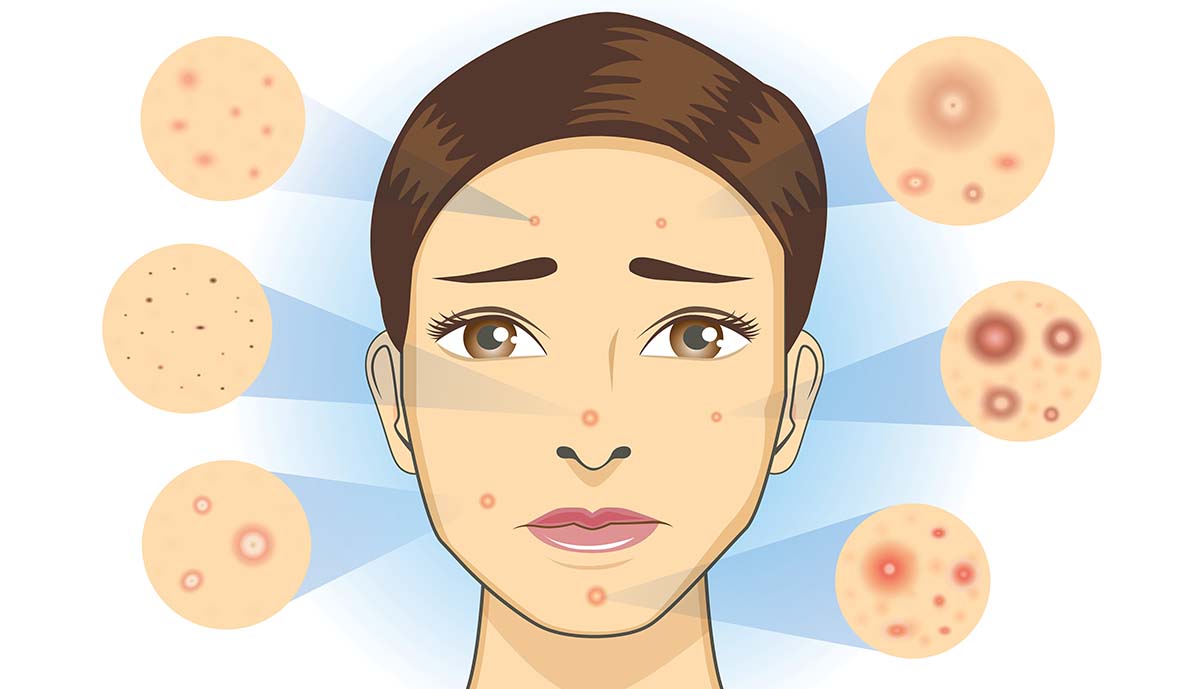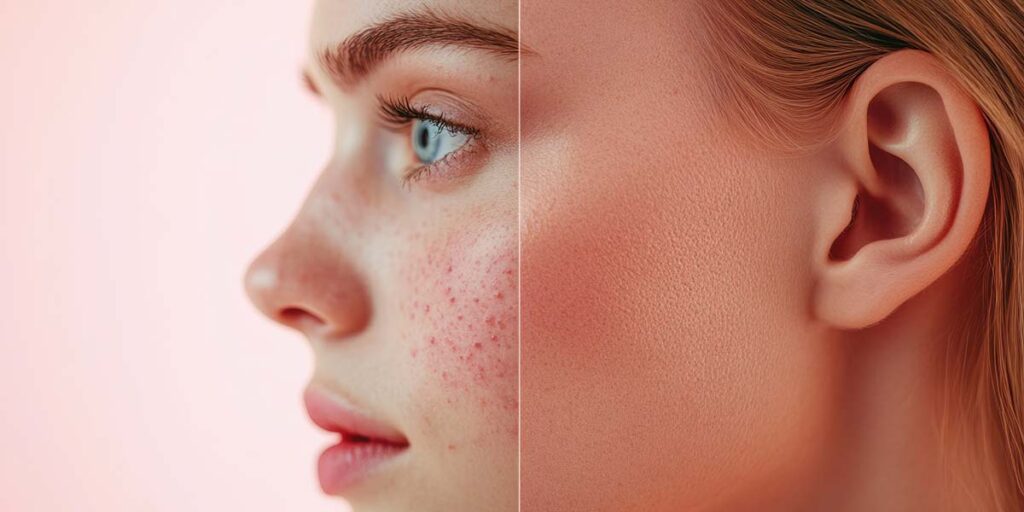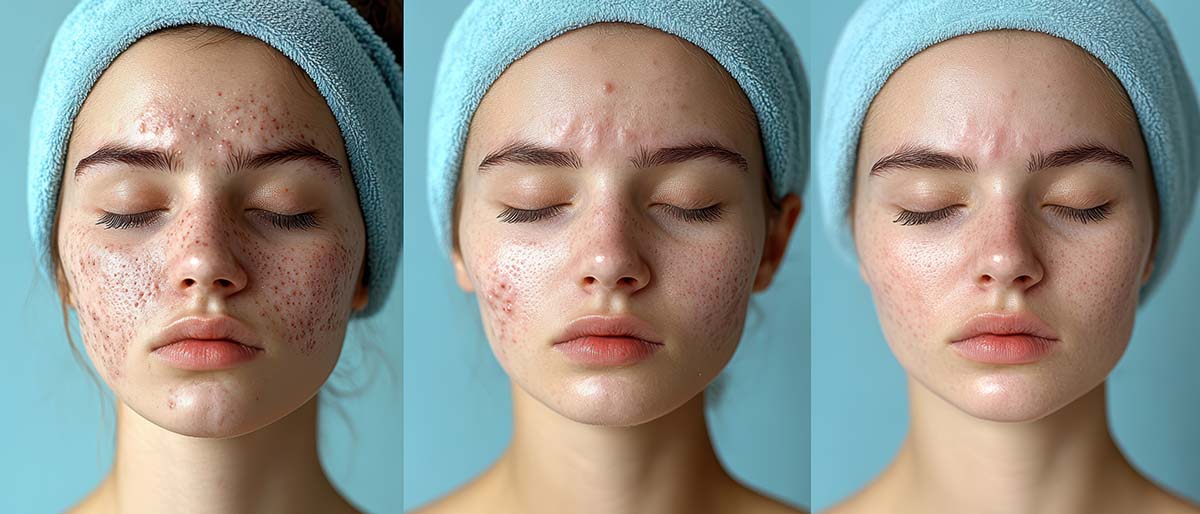Dealing with stubborn acne scars can be frustrating and disheartening. Without the right treatment and understanding of the different types of acne scars, they can linger on your skin for months or even years.
Treating acne scars takes more than purchasing over-the-counter topical creams. While these creams can help with minor skin concerns, they are often not strong enough to tackle the deeper, more noticeable scars.
Whether you’re dealing with shallow marks or deep pitted scars, this helpful guide explores the various types of acne scars, their causes, and the most effective treatments to restore smooth, clear skin.
What Are The Different Types Of Acne Scars?
Acne can cause different types of scars, and it’s common to experience a combination of them. If you’re prone to acne, you might notice the following types of post acne scars:

1. Ice Pick Scars
If you notice deep, narrow indentations in the skin that look like small puncture wounds or deep divots, you may be dealing with ice pick scars. These scars are typically V-shaped or “pitted” and appear as sharp, noticeable dips on the skin’s surface. While they are most commonly found on the cheeks, they can also appear anywhere on the face.
Ice pick scars develop when severe forms of acne, such as cystic or nodular acne, cause significant inflammation beneath the skin. This inflammation leads to the breakdown of tissue and collagen in the affected area.
As the skin tries to heal, it produces new collagen, but when the healing process is disrupted or insufficient, a deep pit forms in the skin’s surface. These scars are most likely to occur when acne is particularly aggressive, and the skin struggles to regenerate effectively.
2. Boxcar Scars
Boxcar scars appear as broad, shallow depressions with well-defined edges. Their shape is often square or oval, giving the skin a pitted, uneven texture. They are most commonly found on the cheeks and temples, where skin tends to be thicker.
Unlike rolling scars, which are caused by skin tethering, boxcar scars result from volume loss in the skin. These broad, shallow scars develop when acne lesions, such as cysts or nodules, damage deep skin layers. As the acne heals, collagen is produced, but tissue loss prevents smooth regeneration, creating a depression in the skin.
3. Rolling Scars
Rolling scars are shallow, wavy scars that create an uneven texture on the skin. Unlike sharp-edged or deep scars, they have a smooth, undulating appearance, resembling waves beneath the skin. These scars are most common on the cheeks and temples, but can occur anywhere acne has caused significant tissue damage.
Rolling scars typically form when deep acne lesions, like cysts or nodules, cause severe inflammation. This affects both the surface and deeper layers, leading to the skin becoming tethered to underlying tissue.
4. Keloid Scars
Keloid scars are thick, raised scars that extend beyond the original acne site, appearing as firm, shiny growths. They can be pink, red, or darker than the surrounding skin and often become more noticeable as they thicken. These scars are most common on the chest, shoulders, neck, and earlobes, but can also appear on the face after severe acne lesions.
Unlike normal scars that remain contained, keloids spread beyond the wound. They form when the body overproduces collagen during healing, resulting in raised scar tissue. While genetics contributes significantly to their development, the exact cause is still not fully understood.
5. Hypertrophic Scars
While they may appear similar to keloids, hypertrophic scars are confined to the boundaries of the original acne lesion and do not spread beyond it. Unlike keloids, they typically flatten and soften over time, but they may remain noticeable.
Hypertrophic scars occur when the body produces too much collagen while healing deep acne lesions, such as cystic acne or nodules. This excess collagen results in raised scar tissue. Hypertrophic scars tend to be more common in individuals with darker skin and are influenced by genetic factors, the severity of the acne, and the skin’s healing process. They generally develop in areas of high tension, such as the chest, back, and shoulders, although they can also form on the face.
6. Pigmentation Scars
Compared to other types of acne scars, post-inflammatory hyperpigmentation (PIH) primarily affects the color of the skin rather than its texture. These scars often appear as dark spots or patches, ranging from red, pink, or purple in fresh scars to brown or even gray in older scars. Over time, pigmentation scars can fade, but they may take several weeks to months to fully resolve.
Pigmentation scars develop when acne inflammation triggers an overproduction of melanin, leading to dark spots or patches.
How to Minimize the Risk of Acne Scarring

While some acne scars can be effectively treated at home, proper prevention is key to minimizing the risk of significant scarring. Here are some effective tips to prevent active acne from turning into different types of acne scars on the face:
- Treat Acne Early: While some people would advise you to ignore your acne and let it “run its course,” this actually doesn’t help in preventing scarring. The longer you wait, the more likely the acne is to cause deeper damage to your skin, increasing the risk of permanent scars. The sooner you address acne, the less time it has to cause lasting damage. Use acne-fighting products like benzoyl peroxide or salicylic acid to target blemishes early and prevent them from worsening.
- Avoid Picking or Squeezing Pimples: Picking at or squeezing acne can push bacteria deeper into the skin, leading to more inflammation and a higher risk of scarring. Gently cleanse your skin and let the blemish heal naturally.
- Use Non-Comedogenic Skincare Products: Opt for skincare and makeup products that are specifically labeled “non-comedogenic.” These products are designed not to clog pores, which helps reduce the likelihood of acne flare-ups. Look for moisturizers, sunscreens, and foundations that are oil-free and formulated for acne-prone skin.
- Apply Sunscreen Regularly: UV exposure can darken existing acne scars, making them more noticeable. Use a broad-spectrum sunscreen with SPF 30 or higher every day to protect your skin from harmful UV rays and prevent further pigmentation.
- Stay Hydrated and Maintain a Healthy Diet: Drinking plenty of water and eating a balanced diet with anti-inflammatory foods can support skin healing and reduce the risk of scarring. Foods rich in antioxidants, like berries and leafy greens, can promote healthy skin regeneration.
Start Your Journey to Clearer, Smoother Skin at Alinea Medical Spa
Acne scars can be challenging to treat, but understanding the different types and how they form is the first step toward managing them effectively. With the right approach, acne scars don’t have to be permanent, and with advanced treatments, you can achieve smoother, healthier skin.
For a more effective and personalized treatment plan, schedule a consultation with a skin expert at Alinea Medical Spa. An experienced specialist will evaluate your skin’s condition and design a targeted approach to treat your acne scars. We offer a wide range of advanced acne scar treatments, including laser therapy, microneedling, chemical peels, and dermal fillers, all designed to help you achieve smoother, clearer skin.




